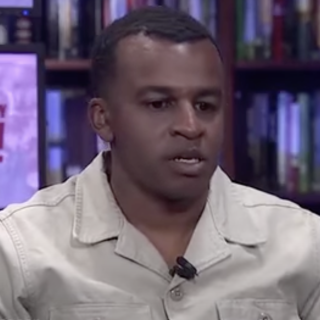Advertisement
Ah, for those halcyon days when the president of the United States was an intellectual and a serious reader. And he can sing, too!
In Grace, Cody Keenan, Obama’s chief White House speechwriter, takes us back to the period from Wednesday, June 17 through Friday, June 26 in the penultimate year of the Obama presidency during which some of the most consequential events during his administration happened and played themselves out.
Prior to working in the White House, Keenan began his career in politics as an unpaid employee in the windowless mail room of the late Senator Ted Kennedy. By the time he left to attend the John F. Kennedy School of Government at Harvard University, he was a legislative aid. Over one summer break during the first Obama presidential campaign, he worked as an intern for Jon Favreau, a junior speechwriter formerly with John Kerry’s presidential campaign staff, and then returned to college in the fall to finish his degree. After Obama’s election, he was hired by Favreau to become part of the speech writing team at the White House. When Favreau left, Keenan was named chief speech writer.
No presidential speech writer has an easy job, but as Keenan said, “To be a speechwriter for Barack Obama is fucking terrifying. . .perhaps more than any president before him [he is] a writer. . . What he wanted from us, as his team of speech writers, was a creative partnership, a collaboration where we could make each other better. Where we could take each other to places we couldn’t reach alone.”
Yet by the time Obama won the presidency, he had already written two well received books, and given the keynote address at the 2004 Democratic convention. Imagine being asked to report to the Oval Office to write a speech for perhaps the most erudite president ever. What could Keenan say that Obama couldn’t say ten times better?
The Oval Office is one of the most famous rooms in America and clearly set up to remind a visitor of the power of its occupant. The furniture was strategically placed and not necessarily the most comfortable, and Obama kept the room warmer than average. Keenan himself said “The gravitas of it squeezes the air from your lungs like pressure at the sea floor.” Even high ranking officials and cabinet members are overwhelmed during their first visit. By 2015, though, Kennan was used to being in the Oval Office, and while he never lost his wonder or respect for the room, his awe of it had eased. While it appears he did not achieve the status of alter ego to Obama as did Ted Sorenson for John F. Kennedy, the two developed a good and collaborative working relationship.
During the ten-day stretch, we see the fiftieth anniversary of the voting rights march across the Edmund Pettus Bridge in Selma, Alabama; the decisions in two Supreme Court cases dealing with the constitutionality of the Patient Protection and Affordable Care Act, referred to as Obama care, and same-sex marriage; and the mass shooting by a young white man of a group of Black people attending a Bible class in Mother Emanuel AME Church in Charleston, South Carolina–Denmark Vesey’s church–during which nine people were killed and one was injured. This period may have been ten of the most momentous days of Obama’s presidency. Together the two men would put pen to paper, contextualizing and elevating these historic events for the American people.
While Keenan doesn’t spend a lot of time focusing on Obama’s first-black-president status, he understands it and knows that race is always lurking in the background. He also knows that Obama is definitely not the kind of person most people in America think of when they think about Blacks, having been reared “half a world away in Hawaii and Indonesia by the white half of his family.” Keenan went on to say of the former president, “When he was a kid, his own parents’ marriage would have been illegal in much of the country; when he was in high school, he endured racial epithets; when he was in college, he was profiled by the police. Through all those indignities, he ended up the first Black president of the Harvard Law Review and, well, the first Black president.” At the end of the day, Keenan neither tiptoes around Obama’s blackness nor shoves it in America’s face.
Surely one of Obama’s most crucial speeches during his eight years in office was the eulogy he gave for the nine victims of the mass shooting at Mother Emanuel AME Church. At first Obama is adamant that he does not want to give a nationwide address about the heinous crime. More than a dozen mass shootings happened during Obama’s tenure in the White House–two of them at Fort Hood in Texas and six of them in on year. One of them involved the mass murder of children, which surely made the president think of his own young daughters. What more could he say? But one of the victims was Reverend Clementa Pinckney, a South Carolina state senator who Obama had briefly met.
He decided he would speak at Pinckney’s service, and include the other eight victims in his remarks. He spoke their names one by one and then he described them. “Good people. Decent people. God-fearing people. People so full of life, and so full of kindness, people who ran the race, who persevered, people of great faith.” He had hinted to his staff that he might sing; he had done it before. When he began, the congregation joined him. “Amazing grace, how sweet the sound that saved a wretch like me; I once was lost, but now I’m found, was blind but now I see.” What a moment!
Grace is a fly-on-the-wall type of book. Keenan’s prose is lively and accessible, and he gives us a very clear understanding about how excellent communication or a lack thereof can make or break an idea or a policy or a relationship. I was so drawn in by the book, I nearly read it straight through.
As America’s first Black president, Barack Obama walked a much higher and more perilous tightrope than any of his predecessors. But according to Kennan, no matter how much the tightrope bent or swayed, Obama’s walk was always graceful.



